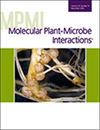Sarah Lipps, Martin Bohn, Jessica Rutkoski, Carolyn Butts-Wilmsmeyer, Santiago Mideros, Tiffany Jamann
求助PDF
{"title":"Comparative Review of <i>Fusarium graminearum</i> Infection in Maize and Wheat: Similarities in Resistance Mechanisms and Future Directions.","authors":"Sarah Lipps, Martin Bohn, Jessica Rutkoski, Carolyn Butts-Wilmsmeyer, Santiago Mideros, Tiffany Jamann","doi":"10.1094/MPMI-08-24-0083-FI","DOIUrl":null,"url":null,"abstract":"<p><p><i>Fusarium graminearum</i> is one of the most important plant-pathogenic fungi that causes disease on wheat and maize, as it decreases yield in both crops and produces mycotoxins that pose a risk to human and animal health. Resistance to Fusarium head blight (FHB) in wheat is well studied and documented. However, resistance to Gibberella ear rot (GER) in maize is less understood, despite several similarities to FHB. In this review, we synthesize existing literature on the colonization strategies, toxin accumulation, genetic architecture, and potential mechanisms of resistance to GER in maize and compare it with what is known regarding FHB in wheat. There are several similarities in the infection and colonization strategies of <i>F. graminearum</i> in maize and wheat. We describe multiple types of GER resistance in maize and identify distinct genetic regions for each resistance type. We discuss the potential of phenylpropanoids for biochemical resistance to <i>F. graminearum.</i> Phenylpropanoids are well characterized, and there are many similarities in their functional roles for resistance between wheat and maize. These insights can be utilized to improve maize germplasm for GER resistance and are also useful for FHB resistance breeding and management. [Formula: see text] Copyright © 2025 The Author(s). This is an open access article distributed under the CC BY-NC-ND 4.0 International license.</p>","PeriodicalId":19009,"journal":{"name":"Molecular Plant-microbe Interactions","volume":" ","pages":"142-159"},"PeriodicalIF":3.4000,"publicationDate":"2025-03-01","publicationTypes":"Journal Article","fieldsOfStudy":null,"isOpenAccess":false,"openAccessPdf":"","citationCount":"0","resultStr":null,"platform":"Semanticscholar","paperid":null,"PeriodicalName":"Molecular Plant-microbe Interactions","FirstCategoryId":"99","ListUrlMain":"https://doi.org/10.1094/MPMI-08-24-0083-FI","RegionNum":3,"RegionCategory":"生物学","ArticlePicture":[],"TitleCN":null,"AbstractTextCN":null,"PMCID":null,"EPubDate":"2025/4/3 0:00:00","PubModel":"Epub","JCR":"Q2","JCRName":"BIOCHEMISTRY & MOLECULAR BIOLOGY","Score":null,"Total":0}
引用次数: 0
引用
批量引用
Abstract
Fusarium graminearum is one of the most important plant-pathogenic fungi that causes disease on wheat and maize, as it decreases yield in both crops and produces mycotoxins that pose a risk to human and animal health. Resistance to Fusarium head blight (FHB) in wheat is well studied and documented. However, resistance to Gibberella ear rot (GER) in maize is less understood, despite several similarities to FHB. In this review, we synthesize existing literature on the colonization strategies, toxin accumulation, genetic architecture, and potential mechanisms of resistance to GER in maize and compare it with what is known regarding FHB in wheat. There are several similarities in the infection and colonization strategies of F. graminearum in maize and wheat. We describe multiple types of GER resistance in maize and identify distinct genetic regions for each resistance type. We discuss the potential of phenylpropanoids for biochemical resistance to F. graminearum. Phenylpropanoids are well characterized, and there are many similarities in their functional roles for resistance between wheat and maize. These insights can be utilized to improve maize germplasm for GER resistance and are also useful for FHB resistance breeding and management. [Formula: see text] Copyright © 2025 The Author(s). This is an open access article distributed under the CC BY-NC-ND 4.0 International license.
禾谷镰刀菌感染玉米和小麦的比较研究:抗性机制的相似性与未来发展方向。
谷物镰刀菌是最重要的植物致病性真菌之一,它会导致小麦和玉米的疾病,因为它会降低这两种作物的产量,并产生对人类和动物健康构成威胁的真菌毒素。小麦对赤霉病(Fusarium head blight, FHB)的抗性进行了充分的研究和记录。然而,尽管与赤霉病有一些相似之处,玉米对赤霉病(GER)的抗性尚不清楚。在这篇综述中,我们综合了现有的关于玉米对GER的定植策略、毒素积累、遗传结构和潜在抗性机制的文献,并将其与小麦对FHB的已知研究进行了比较。在玉米和小麦的侵染和定殖策略上有许多相似之处。我们描述了玉米中多种类型的GER抗性,并确定了每种抗性类型的不同遗传区域。我们讨论了苯丙素对禾本科真菌生化抗性的潜力。苯丙素在小麦和玉米的抗虫功能上有许多相似之处。这些见解可用于改进玉米种质对GER的抗性,也可用于对FHB抗性的育种和管理。
本文章由计算机程序翻译,如有差异,请以英文原文为准。

 求助内容:
求助内容: 应助结果提醒方式:
应助结果提醒方式:


